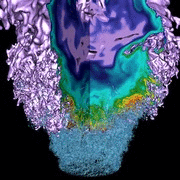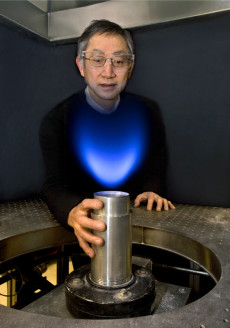Supercomputers Helping Blaze Path to Cleaner Combustion
September 27, 2013
Jon Bashor, jbashor@lbl.gov, +1 510.485.5849
Combustion – the complex chemical process of burning fuels – produces more than 80 percent of our nation’s energy, making it a critical driver behind the American economy and standard of living. In addition to fueling power plants, combustion drives aircraft, ships, locomotives, truck and cars (even hybrids). At home, combustions heats our rooms, cooks our food and dries our clothes.
Yet our understanding of what goes on inside those flames is surprisingly incomplete. At Lawrence Berkeley National Laboratory, applied mathematicians using supercomputers are working directly with combustion scientists to better understand the complex chemistry of combustion to develop devices that burn cleaner, are more efficient and can burn renewable fuels.
One new technology is the low-swirl burner, developed by Robert Cheng in Berkeley Lab’s Environmental Energy Technologies Division. The low-swirl burner is a mechanically simple device that imparts a mild spin to the fuel and air mixture, causing it to spread out and burn at a lower temperature than in conventional burners. Lower flame temperatures increase the efficiency and greatly reduce the amount of nitrogen oxides (NOx) and greenhouse gases produced. Breathing NOx compounds can cause or aggravate health problems such as emphysema, bronchitis, asthma and heart disease.
The design is already being used commercially and Cheng is working to make the device even more efficient and able to burn different fuels, in particular hydrogen. And he is thinking big – designing the low-swirl burner to operate in room-sized combustion chambers used for industry where fuels are burned at high pressure and high temperature.
To improve the burner, Cheng needed a clear understanding of what was going on inside its flames. Scientists can’t insert probes into the flames as this disrupts the chemistry, much like when a camper pokes a stick into a campfire. Lasers can grab split-second images of the flames, but this only provides two-dimensional snapshots and doesn’t capture the intricacies of the continual burning process. He turned to the applied mathematicians and computer scientists of Berkeley Lab’s Center for Computational Sciences and Engineering (CCSE) to help.
The simulation of practical-scale combustion devices like Cheng’s is an immense undertaking. The fuel is often turbulent, the combustion process may involve hundreds of species and thousands of chemical reactions, and the processes involved can span milliseconds to minutes and microns to meters.
“The challenge is daunting because of the range of scales,” Cheng said. In industrial-sized burners, combustion chemistry occurs at the micron scale with the flame burning at 2,800 degrees Fahrenheit and at up to 20 atmospheres of pressure. At these conditions the burners are expected to operate around the clock for up to three years, about 185,000 hours. Compare this with an internal combustion engine in a car, which is designed to last about 10,000 hours with regular maintenance.
Such detailed accuracy in simulations was impossible just a few years ago. However, algorithmic improvements developed by scientists and mathematicians in CCSE have slashed computational costs for combustion simulations by a factor of 10,000 while the number of variables used to specify the solution has increased from hundreds of thousands to more than a billion. The increase in complexity (and fidelity) has made laboratory-scale 3D simulations possible for the first time.

Simulations are helping Cheng understand what's happening inside the low-swirl burner in greater detail than can be observed experimentally.
To create such accurate simulations, CCSE has developed software tools based on adaptive mesh refinement (AMR), a grid-based system that applies maximum computing power to the areas of most interest, while dialing back where there’s little happening.
The latest round of research by the two groups is aimed at adapting the design to burn hydrogen. Burning hydrogen has the benefit of not releasing greenhouse gases, but the fuel burns much faster and releases energy at a higher rate than natural gas. Scientists have found that as the fuel mixture contains more hydrogen, the amount of NOx produced levels off at an extremely low level, but can’t be reduced to zero. Since the goal is to reduce the amount of NOx, the team uses supercomputers at DOE’s National Energy Research Scientific Computing (NERSC) Center to simulate this phenomenon.
“In order to develop clean, energy-efficient systems, we need a continuous feedback loop from the flame to the lab and back again,” Cheng said. “This is the missing link that computation at NERSC provides.”
About Computing Sciences at Berkeley Lab
High performance computing plays a critical role in scientific discovery. Researchers increasingly rely on advances in computer science, mathematics, computational science, data science, and large-scale computing and networking to increase our understanding of ourselves, our planet, and our universe. Berkeley Lab’s Computing Sciences Area researches, develops, and deploys new foundations, tools, and technologies to meet these needs and to advance research across a broad range of scientific disciplines.







 Instagram
Instagram YouTube
YouTube